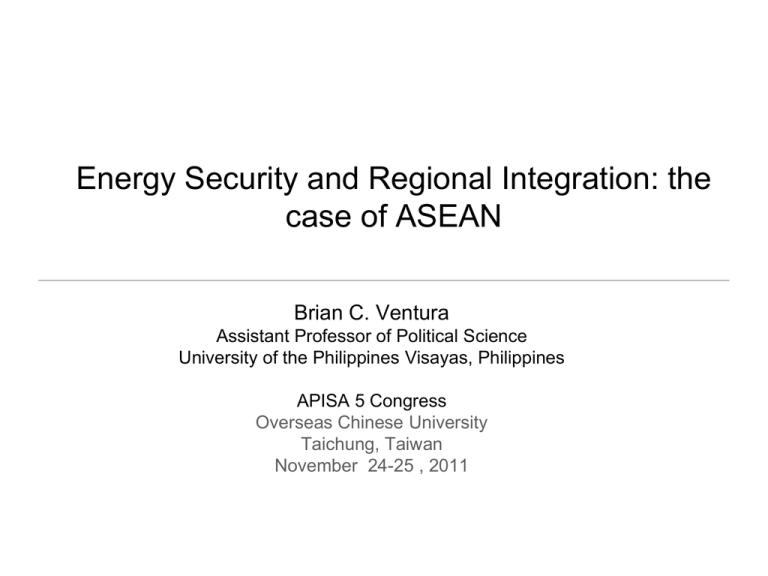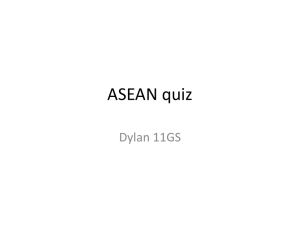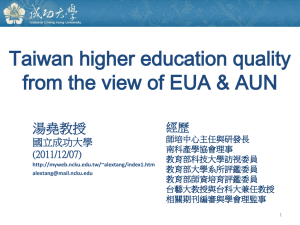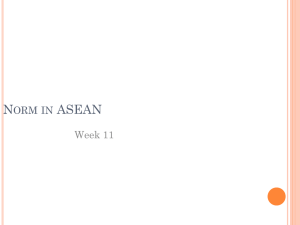Energy Security and Regional Integration: the case of ASEAN
advertisement

Energy Security and Regional Integration: the case of ASEAN Brian C. Ventura Assistant Professor of Political Science University of the Philippines Visayas, Philippines APISA 5 Congress Overseas Chinese University Taichung, Taiwan November 24-25 , 2011 Outline • Transaction Approach • Perspectives • Using transaction approach for ASEAN • ASEAN’s Energy Security Policy • Internal drive • external factors Concluding observations Defining transaction approach • Karl Deutsch (1957) pioneered the use of transaction analysis to measure the development of communities in the international system • suggest that transactions in communities are very diverse in character and are not confined to economic or political, • quantity of transaction flow among members of the community significantly differ from the flow to and from the perceived non-members. Defining transaction approach • Puchala (1971,129) defined transactions as the “contacts and dealing, both governmental and non-governmental, between states.” • transaction flow creates a sense of community • basically, from the transaction approach a group can be defined as a community it they interact with each other much more than with perceived non-member Perspectives in the transaction Comprehensive transaction focus •According to Bram’s (1966, 881) the international system “is not made up of specific transactions between specific countries but the totality of it” therefore understanding requires the calculation of all form of transactions undertaken by all countries in the international community. •Evaluating density of transactions should therefore include political, economic and social exchanges across actors Perspectives in the transaction Context Specific transaction focus •underlines the idea that transaction analysis can be many things for many purposes. •Hughes (1971), for example, suggested that the way transaction itself is conceptualized can produce varying transaction data result that will lend itself to a wide range of analysis. •Buzan’s concept of regional security complex, for example, suggests a security specific fulcrum for classifying a group of actors as a community Transactions approach for the ASEAN • A way of assessing the health of a “caring and sharing” community • Examine state driven attempt to improve transactions flow • movement of goods, people and ideas • What are its limits and potentials Energy Security in Southeast Asia • Energy is seen as part of security therefore the role of the state is very pronounced • There is a diversity of energy security situations among ASEAN member countries, from exporter (Indonesia, Malaysia, Brunei) to highly import dependent (Singapore, Philippines), and strategic transit (Malaysia, Singapore) • Energy resource is a major provider of revenues for some exporting countries, for the state and factions in power, • therefore, control of energy resources is also access to control of national power Proven gas reserve (BP Statistical Review 2010) Proven oil reserve (BP Statistical Review 2010) ASEAN and Energy Transaction Management ASEAN Concord in Indonesia (1976) •energy has been treated as an important basic commodity, giving it equal position as food under the heading of economic cooperation. •The focus has mainly been on management of supply • For import dependent countries this means supply from exporters in the ASEAN • For exporters this means accessible and stable export market ASEAN and Energy Transaction Management • Instruments outlined centers on sharing of risk by sharing oil stocks and guaranteeing adequate supply. • Importance was also placed on the sharing of information, research and the development of alternative technology. ASEAN and Energy Transaction ASEAN Petroleum Security Agreement (Manila 1986) • Spreading risk by supply sharing, as exemplified by the 1986 ASEAN Petroleum Security Agreement signed in Manila, focus not only on the problem of supply shortage but supply surplus as well. • The fact that member countries have diverse level of energy needs define this security strategy. • During this time it was seen that exporting countries like Malaysia, Brunei and Indonesia can supply importing countries like the Philippines, Singapore and Thailand with emergency fuel in case of crises. ASEAN and Energy Transaction • . The ASEAN Plan of Action on Energy Cooperation of 2004-2009 outlined the policy direction of the region into two 1. the increase in interconnection of natural gas and electricity power sector via the proposed ASEAN Power Grid and the Trans-ASEAN Gas Pipeline projects and 2. promotion of energy efficiency and conservation; development of new and renewable energy sources. ASEAN and Energy Transaction External Drivers • Pipeline interconnection is intended to address both reaching markets in the region and improving access for markets outside the region, such as China, and Japan • To reduce dependence of East Asian markets to the use of Malacca Straits. • Investment from other Asian countries, like Japan and China will inevitably bring the regions energy outside the region Conclusion • how integration is politically and administratively attempted even if transaction flow may follow a dissimilar path • As the economic development of the region continues supply depletion will place member countries in a more equal energy security predicament as importer • in this case infrastructure integration will play a different role and the current plan based on complementary resource will no longer be relevant Conclusion • Energy transaction flow management is a vital part of ASEAN’s energy policy integration • The current focus of ASEAN countries is management of material transaction flows, (investment, supply, market access, infrastructure and technology) • There is a need for improvement of non-material transaction flows such as rules and standards.







